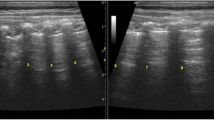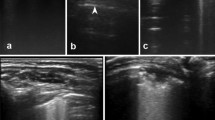Abstract
It is extremely difficult to stratify bronchiolitis and predict the need for admission to the pediatric intensive care unit (PICU). We aimed to evaluate the capacity of a new lung ultrasound score (LUSBRO) to predict the need for admission to the PICU compared to a clinical score. This was a prospective observational single-center study that includes infants < 6 month of age admitted to a hospital due to acute bronchiolitis. Both scores were calculated at admission. The main outcome was PICU admission. Second endpoints were the need for mechanical ventilation, respiratory support duration, and the length of stay in the hospital. Eighty patients were included, with a median age of 53 days (IQR 29–115). Forty-four patients (55%) required PICU admission. LUSBRO score showed a better AUC compared to the clinical score to predict PICU admission: 0.932 (95% CI 0.873–0.990) vs. 0.675 (95% CI 0.556–0.794) and a positive correlation with the hospital length of stay. The best cut-off point for predicting the need for PICU admission for LUSBRO score was 6, showing a sensitivity of 90.91% and a specificity of 88.89%.
Conclusions: The LUSBRO score is a useful tool to predict the need for admission to the PICU.
What is Known • It is extremely difficult to stratify which patients affected by bronchiolitis should be precociously transferred to a third level hospital and will require pediatric intensive care unit (PICU) admission. • Clinical scores have been created but neither of them is accurate. What is New • The LUSBRO score is a useful tool to predict the need for admission to the PICU of patients with bronchiolitis and, consequently, to predict the patients who should be transferred to a tertiary hospital to optimize respiratory support. |



Similar content being viewed by others
Availability of data and material
N/A
Code availability
N/A
Change history
27 February 2021
A Correction to this paper has been published: https://doi.org/10.1007/s00431-021-04003-4
Abbreviations
- LUS:
-
Lung ultrasound
- PICU:
-
Pediatric intensive care unit
- CXR:
-
Chest X-ray
- NIV:
-
Non-invasive ventilation
- HFNC:
-
High-flow nasal cannula
References
Florin TA, Plint AC, Zorc JJ (2017) Viral bronchiolitis. Lancet 389:211–224. https://doi.org/10.1016/S0140-6736(16)30951-5
Anderson EJ, Carbonell-Estrany X, Blanken M, Lanari M, Sheridan-Pereira M, Rodgers-Gray B, Fullarton J, Rouffiac E, Vo P, Notario G, Campbell F, Paes B (2017) Burden of severe respiratory syncytial virus disease among 33-35 weeks’ gestational age infants born during multiple respiratory syncytial virus seasons. Pediatr Infect Dis J 36:160–167. https://doi.org/10.1097/INF.0000000000001377
Mellick LB, Gonzalez J (2019) The Problematic 2014 American Academy of Pediatrics Bronchiolitis Guidelines. Pediatr Emerg Care 35:654–658. https://doi.org/10.1097/PEC.0000000000001915
Ghazaly M, Nadel S (2018) Characteristics of children admitted to intensive care with acute bronchiolitis. Eur J Pediatr 177:913–920. https://doi.org/10.1007/s00431-018-3138-6
Hasegawa K, Tsugawa Y, Brown DFM, Mansbach JM, Camargo CA (2013) Trends in bronchiolitis hospitalizations in the United States, 2000-2009. Pediatrics 132:28–36. https://doi.org/10.1542/peds.2012-3877
Green CA, Yeates D, Goldacre A, Sande C, Parslow RC, McShane P, Pollard AJ, Goldacre MJ (2016) Admission to hospital for bronchiolitis in England: trends over five decades, geographical variation and association with perinatal characteristics and subsequent asthma. Arch Dis Child 101:140–146. https://doi.org/10.1136/archdischild-2015-308723
Golan-Tripto I, Goldbart A, Akel K, Dizitzer Y, Novack V, Tal A (2018) Modified Tal Score: validated score for prediction of bronchiolitis severity. Pediatr Pulmonol 53:796–801. https://doi.org/10.1002/ppul.24007
Balaguer M, Alejandre C, Vila D, Esteban E, Carrasco JL, Cambra FJ, Jordan I (2017) Bronchiolitis Score of Sant Joan de Déu: BROSJOD Score, validation and usefulness. Pediatr Pulmonol 52:533–539. https://doi.org/10.1002/ppul.23546
Di Mauro A, Ammirabile A, Quercia M et al (2019) Acute bronchiolitis: is there a role for lung ultrasound? Diagnostics 9:1–13. https://doi.org/10.3390/diagnostics9040172
Bobillo-Perez S, Girona-Alarcon M, Rodriguez-Fanjul J, Jordan I, Balaguer Gargallo M (2019) Lung ultrasound in children: what does it give us? Paediatr Respir Rev 36:136–141. https://doi.org/10.1016/j.prrv.2019.09.006
Abdelmawla M, Louis D, Narvey M, Elsayed Y (2019) A lung ultrasound severity score predicts chronic lung disease in preterm infants. Am J Perinatol 36:1357–1361. https://doi.org/10.1055/s-0038-1676975
De Martino L, Yousef N, Ben-Ammar R et al (2018) Lung ultrasound score predicts surfactant need in extremely preterm neonates. Pediatrics 142. https://doi.org/10.1542/peds.2018-0463
Buonsenso D, Tomà P, Scateni S, Curatola A, Morello R, Valentini P, Ferro V, D’Andrea ML, Pirozzi N, Musolino AM (2020) Lung ultrasound findings in pediatric community-acquired pneumonia requiring surgical procedures: a two-center prospective study. Pediatr Radiol 50:1560–1569. https://doi.org/10.1007/s00247-020-04750-w
Musolino AM, Tomà P, Supino MC et al (2019) Lung ultrasound features of children with complicated and noncomplicated community acquired pneumonia: a prospective study. Pediatr Pulmonol:ppul.24426. https://doi.org/10.1002/ppul.24426
Marin JR, Abo AM, Arroyo AC, Doniger SJ, Fischer JW, Rempell R, Gary B, Holmes JF, Kessler DO, Lam SHF, Levine MC, Levy JA, Murray A, Ng L, Noble VE, Ramirez-Schrempp D, Riley DC, Saul T, Shah V, Sivitz AB, Tay ET, Teng D, Chaudoin L, Tsung JW, Vieira RL, Vitberg YM, Lewiss RE (2016) Pediatric emergency medicine point-of-care ultrasound: summary of the evidence. Crit Ultrasound J 8:16. https://doi.org/10.1186/s13089-016-0049-5
Ellington LE, Gilman RH, Chavez MA, Pervaiz F, Marin-Concha J, Compen-Chang P, Riedel S, Rodriguez SJ, Gaydos C, Hardick J, Tielsch JM, Steinhoff M, Benson J, May EA, Figueroa-Quintanilla D, Checkley W, Lung Ultrasound for Pneumonia Assessment (LUPA) Study Investigators (2017) Lung ultrasound as a diagnostic tool for radiographically-confirmed pneumonia in low resource settings. Respir Med 128:57–64. https://doi.org/10.1016/j.rmed.2017.05.007
Raimondi F, Yousef N, Migliaro F, Capasso L, de Luca D (2018) Point-of-care lung ultrasound in neonatology: classification into descriptive and functional applications. Pediatr Res:1–8. https://doi.org/10.1038/s41390-018-0114-9
Biagi C, Pierantoni L, Baldazzi M, Greco L, Dormi A, Dondi A, Faldella G, Lanari M (2018) Lung ultrasound for the diagnosis of pneumonia in children with acute bronchiolitis. BMC Pulm Med 18:1–10. https://doi.org/10.1186/s12890-018-0750-1
Ralston SL, Lieberthal AS, Meissner HC, Alverson BK, Baley JE, Gadomski AM, Johnson DW, Light MJ, Maraqa NF, Mendonca EA, Phelan KJ, Zorc JJ, Stanko-Lopp D, Brown MA, Nathanson I, Rosenblum E, Sayles S 3rd, Hernandez-Cancio S, American Academy of Pediatrics (2014) Clinical practice guideline: the diagnosis, management, and prevention of bronchiolitis. Pediatrics 134:e1474–e1502. https://doi.org/10.1542/peds.2014-2742
Basile V, Di Mauro A, Scalini E et al (2015) Lung ultrasound: a useful tool in diagnosis and management of bronchiolitis. BMC Pediatr 15:1–8. https://doi.org/10.1186/s12887-015-0380-1
Supino MC, Buonsenso D, Scateni S, Scialanga B, Mesturino MA, Bock C, Chiaretti A, Giglioni E, Reale A, Musolino AM (2019) Point-of-care lung ultrasound in infants with bronchiolitis in the pediatric emergency department: a prospective study. Eur J Pediatr 178:623–632. https://doi.org/10.1007/s00431-019-03335-6
Cohen JS, Hughes N, Tat S, Chamberlain JM, Teach SJ, Boniface K (2017) The utility of bedside lung ultrasound findings in bronchiolitis. Pediatr Emerg Care 33:97–100. https://doi.org/10.1097/PEC.0000000000000820
Bueno-Campaña M, Sainz T, Alba M, del Rosal T, Mendez-Echevarría A, Echevarria R, Tagarro A, Ruperez-Lucas M, Herrreros ML, Latorre L, Calvo C (2019) Lung ultrasound for prediction of respiratory support in infants with acute bronchiolitis: a cohort study. Pediatr Pulmonol 54:873–880. https://doi.org/10.1002/ppul.24287
Brat R, Yousef N, Klifa R, Reynaud S, Shankar Aguilera S, de Luca D (2015) Lung ultrasonography score to evaluate oxygenation and surfactant need in neonates treated with continuous positive airway pressure. JAMA Pediatr 169:1–8. https://doi.org/10.1001/jamapediatrics.2015.1797
Loi B, Vigo G, Baraldi E et al (2020) Lung ultrasound to monitor extremely preterm infants and predict BPD: Multicenter longitudinal cohort study. Am J Respir Crit Care Med:rccm.202008–rccm.3131OC. https://doi.org/10.1164/rccm.202008-3131OC
Bressan S, Balzani M, Krauss B, Pettenazzo A, Zanconato S, Baraldi E (2013) High-flow nasal cannula oxygen for bronchiolitis in a pediatric ward: a pilot study. Eur J Pediatr 172:1649–1656. https://doi.org/10.1007/s00431-013-2094-4
Baudin F, Emeriaud G, Essouri S, Beck J, Javouhey E, Guerin C (2019) Neurally adjusted ventilatory assist decreases work of breathing during non-invasive ventilation in infants with severe bronchiolitis. Crit Care 23:5–7. https://doi.org/10.1186/s13054-019-2379-8
Essouri S, Laurent M, Chevret L, Durand P, Ecochard E, Gajdos V, Devictor D, Tissières P (2014) Improved clinical and economic outcomes in severe bronchiolitis with pre-emptive nCPAP ventilatory strategy. Intensive Care Med 40:84–91. https://doi.org/10.1007/s00134-013-3129-z
Millán N, Alejandre C, Martinez-Planas A, Caritg J, Esteban E, Pons-Òdena M (2017) Noninvasive respiratory support during pediatric ground transport: implementation of a safe and feasible procedure. Respir Care 62:558–565. https://doi.org/10.4187/respcare.05253
Fujiogi M, Goto T, Yasunaga H, Fujishiro J, Mansbach JM, Camargo CA Jr, Hasegawa K (2019) Trends in bronchiolitis hospitalizations in the United States: 2000-2016. Pediatrics 144. https://doi.org/10.1542/peds.2019-2614
Breakell R, Thorndyke B, Clennett J, Harkensee C (2018) Reducing unnecessary chest X-rays, antibiotics and bronchodilators through implementation of the NICE bronchiolitis guideline. Eur J Pediatr 177:47–51. https://doi.org/10.1007/s00431-017-3034-5
Taveira M, Yousef N, Miatello J, Roy C, Claude C, Boutillier B, Dubois C, Pierre AF, Tissières P, Durand P (2018) Can a simple lung ultrasound score predict length of ventilation for infants with severe acute viral bronchiolitis? Arch Pediatr 25:112–117. https://doi.org/10.1016/j.arcped.2017.11.005
Jaworska J, Komorowska-Piotrowska A, Pomiećko A, Wiśniewski J, Woźniak M, Littwin B, Kryger M, Kwaśniewicz P, Szczyrski J, Kulińska-Szukalska K, Buda N, Doniec Z, Kosiak W (2020) Consensus on the application of lung ultrasound in pneumonia and bronchiolitis in children. Diagnostics 10:935. https://doi.org/10.3390/diagnostics10110935
Buonsenso D, Soldati G, Curatola A, Morello R, de Rose C, Vacca ME, Lazzareschi I, Musolino AM, Valentini P (2020) Lung ultrasound pattern in healthy infants during the first 6 months of life. J Ultrasound Med 39:2379–2388. https://doi.org/10.1002/jum.15347
Buonsenso D, Supino MC, Giglioni E, Battaglia M, Mesturino A, Scateni S, Scialanga B, Reale A, Musolino AMC (2018) Point of care diaphragm ultrasound in infants with bronchiolitis: a prospective study. Pediatr Pulmonol 53:778–786. https://doi.org/10.1002/ppul.23993
Mecklin M, Heikkilä P, Korppi M (2017) Low age, low birth weight and congenital heart disease are risk factors for intensive care in infants with bronchiolitis. Acta Paediatr 106:2004–2010. https://doi.org/10.1111/apa.14021
Buonsenso D, Malamisura M, Musolino AM (2020) Point-of-care ultrasound training programs across Italian pediatric residency schools. Pediatr Emerg Care. https://doi.org/10.1097/PEC.0000000000002107
Acknowledgements
To the children and families which accepted to join the study.
Author information
Authors and Affiliations
Contributions
JRF, SBP, PG, MC, NLL CS, and MR conceived and designed the study. JRF and SBP analyzed the data. JRF, SBP, CS, wrote the first draft of the manuscript. JRF, SBP, PG, MC, NLL CS, and MR contributed to the writing of the manuscript. All authors agree with the manuscript results and conclusions, jointly developed the structure and arguments for the paper, made critical revisions, and reviewed and approved the final version of the manuscript.
Corresponding author
Ethics declarations
Ethical approval and consent to participate
Parental informed consent was obtained from all patients.
Consent for publication
This study was approved by the local Ethical Assistance Committee and the institutional review board. This study was approved by the local Ethical Assistance Committee and the institutional review board.
Conflict of interest
The authors declare no competing interests.
Additional information
Communicated by Daniele De Luca
Publisher’s Note
Springer Nature remains neutral with regard to jurisdictional claims in published maps and institutional affiliations.
The original online version of this article was revised: The author names on the authorship section of the published version of the above article were interchanged. The names are now presented correctly above.
Supplementary information
Supplementary Figure 1
Violin plot representing the different values of the LUSBRO score (plot 1) and BROSJOD score (plot 2) regarding the maximum support required during the hospital admission. HFNC: high-flow nasal cannula; MV: mechanical ventilation; NC: nasal cannula; NIV: non-invasive ventilation. (PNG 8951 kb).
Rights and permissions
About this article
Cite this article
Bobillo-Perez, S., Sorribes, C., Gebellí, P. et al. Lung ultrasound to predict pediatric intensive care admission in infants with bronchiolitis (LUSBRO study). Eur J Pediatr 180, 2065–2072 (2021). https://doi.org/10.1007/s00431-021-03978-4
Received:
Revised:
Accepted:
Published:
Issue Date:
DOI: https://doi.org/10.1007/s00431-021-03978-4




